#keiko higuchi
Explore tagged Tumblr posts
Text

Albedo Gravitas Presents 2024.4.13(SAT)@Ogikubo Velvet Sun adv 2500yen / door 2800yen +1drink open 18:15 / start 19:00 bugs cry what (吉本裕美��: guitar, daxophone, 狩俣道夫: flute, saxophone, voice, etc.) タカスギケイ + SAWADA Albedo Gravitas (Keiko Higuchi: piano, drums, voice, vocals, Sachiko: voice, electronics, etc, Shizuo Uchida: 4strings)
bugs cry what
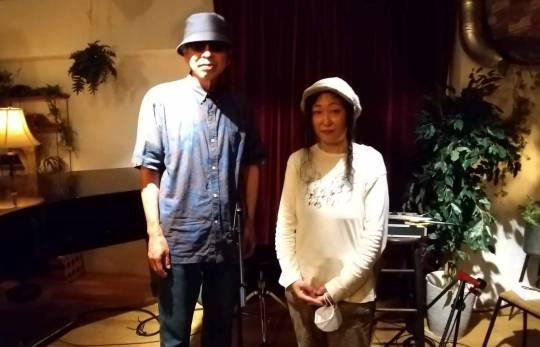
吉本裕美子(guitar/daxophone)と狩俣道夫(flute/ saxophone/voice/etc.)による即興演奏デュオ。息や声の音を多く含むフルートと肉声のようなダクソフォンの音、イレギュラーな演奏スタイルのエレクトリック・ギターやサキソフォン、ヴォイスなどが絡みあい多彩な様相を表出する。2013年以降、東京都内やその近郊の会場で数多く共演を重ね、2019年7月アルバム「bugs cry what」(CD/jigen 020)発表を機にユニット名 bugs cry what を名乗る。 https://www.facebook.com/bugscrywhat/ http://www.jigen-p.net/catalog/catalog-1879
youtube
タカスギケイ + SAWADA

Kei Takasugi(タカスギケイ)(guitar, effects) 1974年生まれ 17歳で渡米。1995年~1998年Berklee College of music / Mick Goodrickに師事。2005年ブラジルサンパウロに渡り活動 / 帰国後ソロ活動を開始。複数のディレイを扱う空間系ギターを主なスタイルとしアンビエントミュージック、ポストロック, コンテンポラリージャズ、フリーインプロビゼーションなどソロや複数のユニット等でジャンルレスに活動中。https://takasugik.jimdofree.com SAWADA(snare drum) 音楽雑誌編集部勤務を経た後、サウンドエンジニアを志す。その傍らドラムを演奏。ソロユニットsnare drum soloをスタート後、アーティストビザを取得しドイツへ移住。ヨーロッパ各地のフェスやクラブで演奏経験を持つ。ドイツの前衛ロックバンドFaustが主催するAvantgarde Festivalに過去7回出演。 http://www.snaredrumsolo.com Albedo Gravitas
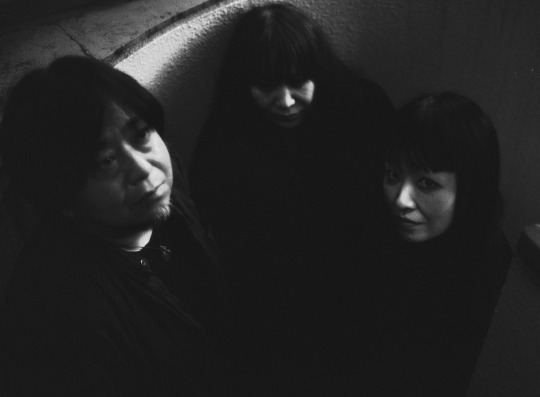
Albedo Gravitas (Albedo Fantastica+内田静男) ヒグチケイコとSachikoで結成された即興ユニット「Albedo Fantastica」に内田静男(4strings)が加わったトリオ。Albedo Fantasticaのボーカルを基軸に展開するサウンドダイナミクスに、内田の変幻自在な低音の振動が加わり未明のサイケデリアが表出する。都内を中心に活動中。23年セカンドアルバム「luminescence」をリリース。 https://albedofantastica.tumblr.com/
2 notes
·
View notes
Text

Albedo Gravitas Presents 2025.4.5(SAT)@Ogikubo Velvet Sun adv 2500yen / door 3000yen +1drink open 18:15 / start 19:00 ミクロマクロ / Albedo Gravitas

ミクロマクロ / HACHIYA Maki (vocal, voice, effects, piano, compositions), KATO Takayuki(guitar, effects) 蜂谷真紀の声と、加藤崇之のギターによるアコースティク即興デュオ。即興にして「短編集」、ミラクルな呼吸の連鎖が生んだ、自然で美しい幻想。「2人だけのノンジャンル」の結晶。 蜂谷真紀 自作曲、JAZZ、即興…日本と海外で垣根のない音の冒険を続け精鋭たちと生み出した音は数知れない。自己のユニットとして、ミクロマクロ(w / 加藤崇之)、HANA⚪︎TORI ( w / 田中信正)、とりかぶつ( w / 武田理沙)、次ナルJAZZ問答( w / 松島啓之, 類家心平, 須川崇志, 本田珠也)、解放地帯( w / 加藤崇之, 本田珠也)ほか、リーダーCDを8作リリースしている。
加藤崇之 ガットギターによるソロ、エレクトリックギターによるソロ、宅SHOOMY朱美、さがゆき、蜂谷真紀ら個性派でフリースタイルのボーカルとの活動、ベテランから若手まであらゆるミュージシャンとのフリージャズや、インプロの交流、三味線弾き語りの柳家小春さんとの和ボサやブラジル音楽など、積極的にライブ活動を行っている。

Albedo Gravitas ヒグチケイコとSachikoで結成された即興ユニット「Albedo Fantastica」に内田静男(4strings)が加わったトリオ。Albedo Fantasticaのボーカルを基軸に展開するサウンドダイナミクスに、内田の変幻自在な低音の振動が加わり未明のサイケデリアが表出する。都内を中心に活動中。23年セカンドアルバム「luminescence」をリリース。
0 notes
Text
Tanbi to Heroine - Literary classics adapted into shoujo manga
I want to talk about the book of my dreams: Mangaka! Sekai Bungaku - Tanbi to Heroine (マンガ化! 世界文学 耽美とヒロイン). It's a compilation of shoujo manga from the 1970s and 1980s which are adaptations of classics from world literature. Each manga has a little introduction about its artist, and the work it was adapted from. Thank you, our Tosho no Ie overlords.
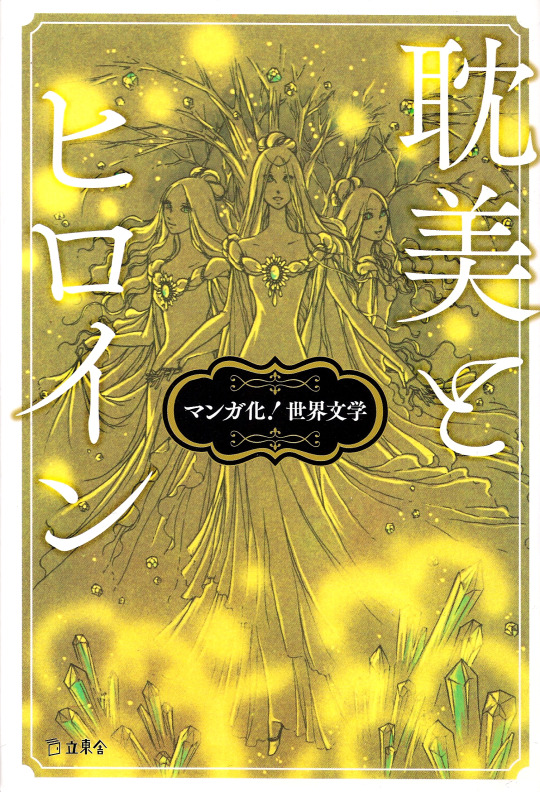
It came out in 2022, and I'm so happy to own this book. After watching Aoi Bungaku and falling in love with what they did with Kokoro there, I've always wanted to see more anime/manga adaptations of literature. Seeing how authors/directors give the works their own interpretations while still staying faithful to the original work, and not trying to do a 1:1 adaptation can be great, as long as they don't jump the shark. Speaking of which, I even liked Gankutsuou despite the bizarre 3D space mecha fights because Edmond Dantès was still there. I can't get mad at it when the director gets the core of the work right.
Anyway, I want to present this awesome book and the manga collected in this volume!
Hagio Moto – Shiroi Tori ni Natta Shoujo (白い鳥になった少女)
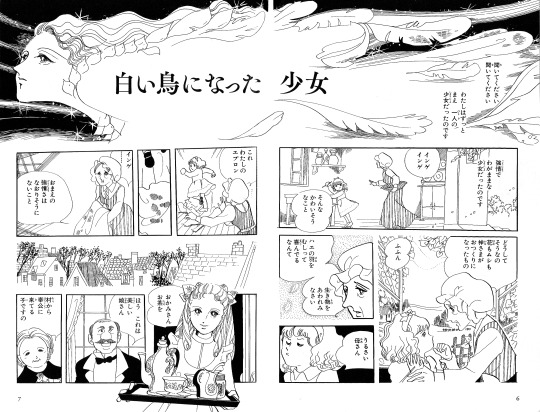
Adapted from Andersen's The Girl Who Trod on A Loaf, and first published in Bessatsu Shoujo Comic 1972/12.
Hagio tells the story from the point of view of the girl who becomes a bird at the end of the tale, which is a very nice touch.
2. Mizuno Hideko – Cendrillon (サンドリヨン)
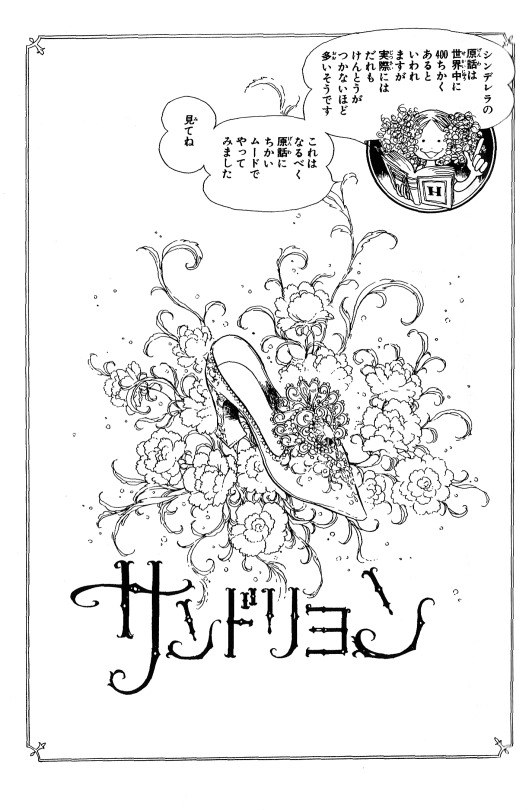
Adapted from Grimm Brothers' Cinderella, and first published in LaLa 1977/9 & 11.
With Mizuno's exquisite art, this Cinderella adaptation is the perfect fairy tale. On the first and last pages Hideko-tan breaks the fourth wall to give us information about the original work, and going "bruh, these are supposed to be tales for kids but some brutal stuff goes on in them. What's with all the mutilations and eye-gouging?!" It's adorable!
3. Maki Miyako – Hanakagerou (花陽炎)

Adapted from Murasaki Shikibu's The Tale of Genji, and first published in Big Comic for Lady 1987/2.
This excerpt is taken from vol. 2 of Maki's Genji Monogatari adaptation, and depicts a scene that doesn't exist in the original work: Hikaru meeting Lady Fujitsubo for the first time. I must say that all that Genji Monogatari Japanese went over my head ;_;
4. Miuchi Suzue – Takekurabe (たけくらべ)
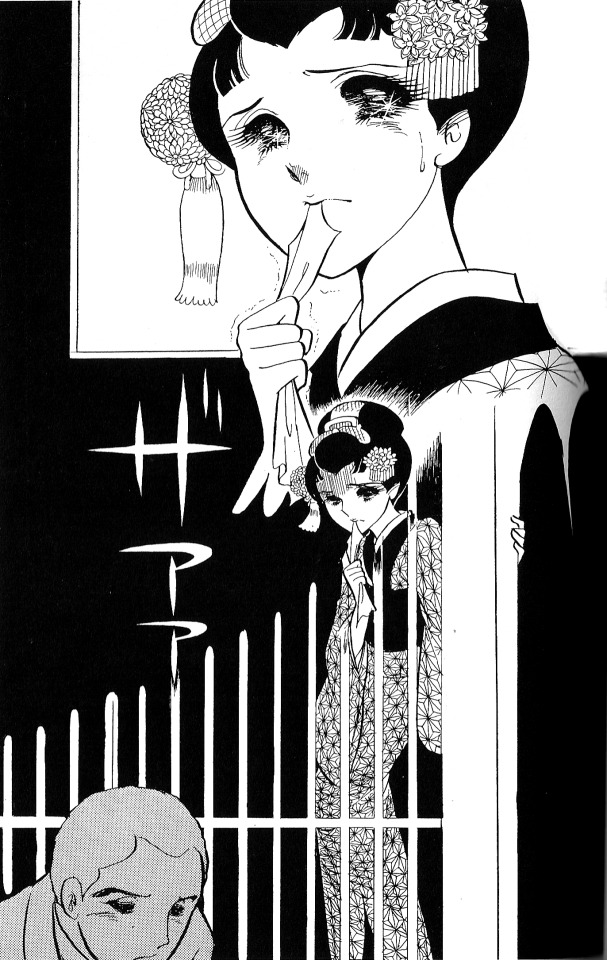
Adapted From Higuchi Ichiyou's Takekurabe, and first published in Hana to Yume 1977/1 & 2. This story is actually part of Miuchi's Glass Mask. In the manga, it was acted in the third act, “Kaze no Naka wo Iku.” Compiled in vol.s 3-4 Hana to Yume comics version, vol.s 2-3 of Hakusensha Bunko, and vol.s 3-4 of the digital ebook.
Conveying the subtleties of the character through the way Ayumi and Maya acts is quite ingenious. We get adaptation-ception with this one, and I loved it. It really made me want to read the book to get to know Midori better.
5. Sakata Keiko – Okisaki to Nemuri Hime (お妃と眠り姫)
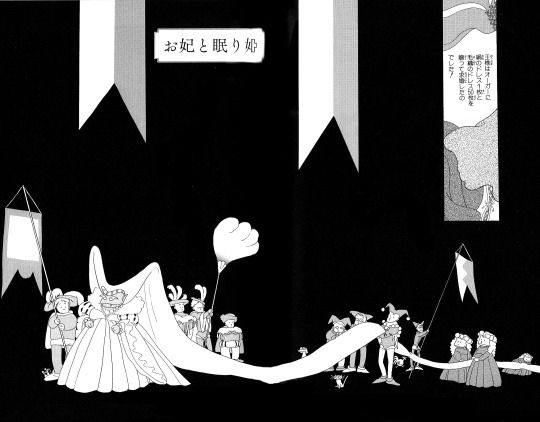
Adapted from Charles Perrault's Sleeping Beauty, and first published in Comic Tom 1989/1.
I haven't read Sakata's works, but she always strikes me as being the odd one in the shoujo scene. And this manga just strengthened my conviction. Her adaptation of Sleeping Beauty focuses on the ogre mother of the Prince, and her loneliness. Which is another ingenious way of going about adapting a fairy tale from a completely point of view. Her funny-looking art and humor adds to it.
6. Fumizuki Kyouko – Shiroki Mori no Chi ni (白き森の地に)

You get this color image I found online, because scanning this gorgeous double spread was impossible. And it's in grayscale in the book.
Adapted from Louis Hémon's Maria Chapdelaine, and first published in Bessatsu Shoujo Friend 1977/3.
I had no idea about this story, but wow, Hémon sure lived a life... This story that takes place in Canada feels really comforting. I'm surprised this didn't get an anime adaptation. Sure, it's not long enough for one, but it'd make a perfect comfort shoujo. "Comfort shoujo" as in people dying and the protagonist growing up after being hit by misery and having to make life-altering choices. I can see why this was popular in Japan.
7. Yamagishi Ryouko – Rapunzel Rapunzel (ラプンツェル・ラプンツェル)
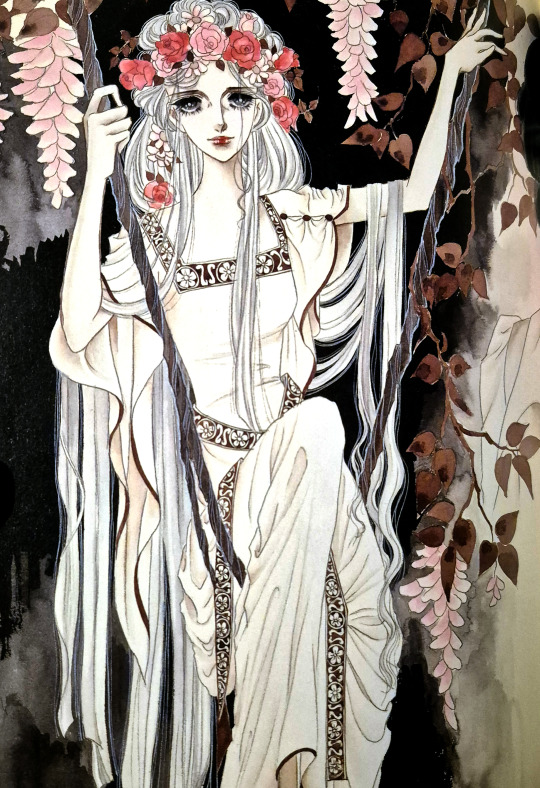
Feast your eyes on this color Rapunzel illustration from the Yamagishi artbook I have.
Adapted from Grimm Brothers's Rapunzel, and first published in Bessatsu Shoujo Friend 1974/6.
Queen Yamagishi does not disappoint: We go full psychological and read about how parents ruin childrens' lives by projecting their shortcomings in life onto them, and their twisted sense of "love" can be worse than a sorceress's curse. Prince charming therapy time, baby!
8. Sato Shio – Bijo to Yajuu (美女と野獣)
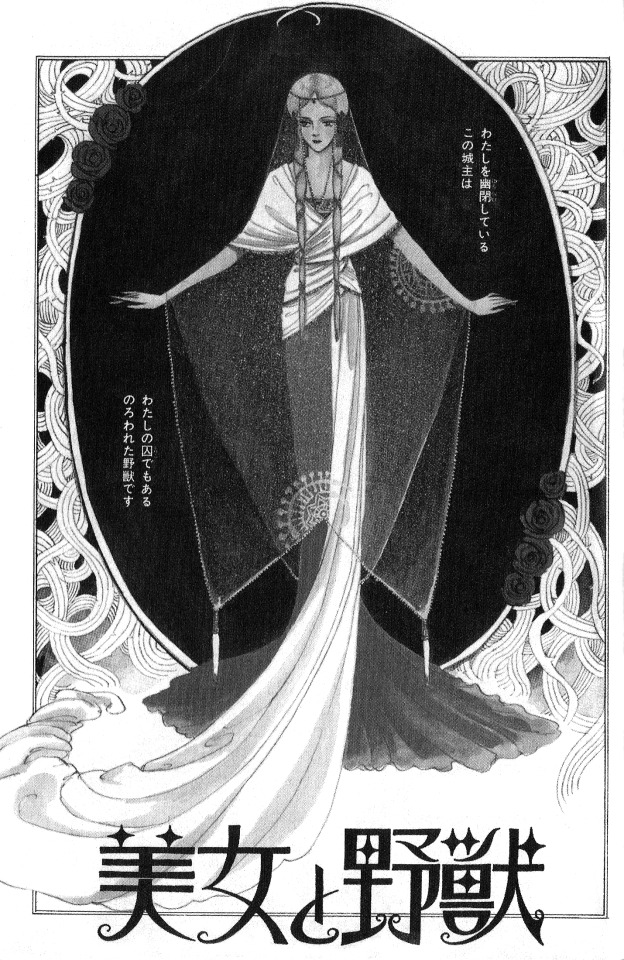
Adapted from Madame de Beumont's Beauty and the Beast, and first published in Papermoon Shoujo Manga Fantasy Shoujo Manga – 1001 Nights (5.11.1980).
This short yet poignant adaptation really brings out the love in the story. She distilled the tale, and left what touches your heart the most in these 8 pages.
This work was also originally published in full color, and it's so gorgeous that I bought the book it was first published in. I hope to have it within the month.
So yeah, if you need to gift something to your old-shoujo loving friend, you now know what to get :)
#萩尾望都#hagio moto#hans christian andersen#水野英子#mizuno hideko#cinderella#grimm brothers#牧美也子#genji monogatari#maki miyako#the tale of genji#美内すずえ#miuchi suzue#glass mask#glass no kamen#takekurabe#higuchi ichiyo#坂田靖子#sakata keiko#charles perrault#sleeping beauty#文月今日子#fumizuki kyouko#louis hémon#maria chapdelaine#山岸凉子#yamagishi ryouko#rapunzel#佐藤史生#sato shio
52 notes
·
View notes
Text
insect parent akutagawa but he has all his insects named and only refers to them as that
akutagawa: yuki was really misbehaving today
tachihara: ? is that a mafia member or--
and no one knows who he's talking about and theyre all very confused
higuchi: so where does kara live?
akutagawa, thinking of his butterfly habitat: in a cage in my living room
higuchi: ????????????????
and he gets very upset when ppl dont call the right insect the right name
atsushi: oh hey there aiko
akutagawa, upset: that's keiko
atsushi, squinting at the ants in thei ant farm: uh if you say so--
138 notes
·
View notes
Text

☆ Leo's intro ☆
Hi I'm Leo <3 !!
He / they , mlm + cupioromantic !
• my interests are BSD , Demon Slayer , Spongebob , Sonic , Danganronpa , MHA, Beyblade Burst. As for my music interests:
Kpop (mostly Twice , BTS , Stray kids and Aespa) , stromae , Beabadoobee , Mitski , laufey , Ricky Montgomery , The smiths (thanks to my friend Michael !!) , will wood etc !!
What I'll post on this account: Oc x canon , wlw art , mlm art , angst , fluff , comfort !!
Some examples of my ocs x canon ships (Kny sonic and bsd) : Shinobu Kochou x Ryouka Satoshi , Sanemi Shinazugawa x Hayato Miyake , Aoi Kanzaki x Hoshi Surushima ==> KNY
Dazai Osamu x Sayaka Murata , Chuuya Nakahara x Shintaro Ishihara , Fyodor Dostoevsky x Simone Debeauvoir , Mark Twain x Thomas 'Tommy' Mann , Higuchi Ichiyo x Yoko Ogawa , Kyouka Izumi x Keiko Furukura , Elena Poniatowska x Edgar Allan Poe (this is more a platonic one instead of romantic).==> BSD
Miko the ocelot x Honey the cat , Yun the kitsune x Silver the hedgehog , Melissa the white rabbit x Blaze the cat , that's all I think...🙌🏻
As you can see I have a LOT of ships 😔
Anyways , hope we can be friends.

BYE <3333
2 notes
·
View notes
Text
— Assigning them songs.
Featuring: Lumi Ackerman, Shiori Gojo, Hikari Keiko, Yuki Asano
— Lumi Ackerman:
Akuma no Ko — Ai Higuchi
— Shiori Gojo
more than words — Hitsujibungaku
— Hikari Keiko
Idol — YOASOBI
— Yuki Asano
Guitar, Loneliness, and Blue Planet — Kessoku Band
tagging my friends 😍: @ravenmoon903 @stellas-starry-stories13
#♡~lumi ackerman~♡#♡~shiori gojo~♡#♡~hikari keiko~♡#♡~yuki asano~♡#☆♡~my art!~♡☆#<- music is an art so it counts 🤫🧏♀️
2 notes
·
View notes
Text

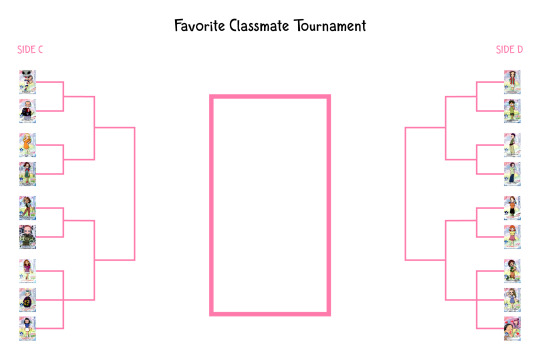

Welcome to the Favorite Classmate Tournament!
This is gonna be a big one. Due to the number of classmates and the fact i couldn't evenly distribute it in a number of pairs and sides that made sense for the brackets (maybe there's a way and I'm just bad at math), every side initially includes 3 pairs and 1 trio each, and finals will be a poll between 3 contenders and y'all will have to live with that, I did my best.
As always, pairs/trios and their order in the bracket were randomly generated.
Complete list of polls under the cut, they'll be linked as soon as they're posted. Polls will be open for a week. May your fave win!
Side A
Yuji Sagawa vs Masato Rinno
Natsumi Sato vs Jun Sato
Minto Wada vs Naomi Okuyama
Kazuya Yoshida vs Hajime Kikuchi vs Michiaki Watabe
Side B
Mutsumi Kudo vs Itoko Hamada
Manabu Takagi vs Kota Amano
Hiroko Kine vs Miho Maruyama
Ichiro Hirano vs Kenta Iizuka vs Marina Koizumi
Side C
Koji Ito vs Kotaro Okajima
Tamaki Reika vs Yuko Koyama
Yoko Manda vs Kayoko Nagato
Shino Hanada vs Nobuaki Yamauchi vs Keiko Yamamoto
Side D
Yukari Umeno vs Masayoshi Nakajima
Takeshi Hasebe vs Maki Higuchi
Noriko Kano vs Nanako Okada
Junji Manda vs Sachiko Ijuuin vs Goji Nakata
Side E
Sora Miyamae vs Masaharu Miyamoto
Masaru Yada vs Takuro Hagiwara
Yutaka Ota vs Dai Morikawa
Kotake Tetsutya vs Kanae Iida vs Ryota Hayashi
Side F
Susumu Yanagida vs Aya Matsushita
Nobuko Yokokawa vs Kenji Ogura
Shiori Nakayama vs Kaori Shimakura
Takao Kimura vs Toyokazu Sugiyama vs Shouta Taniyama
3 notes
·
View notes
Text
2024年1月ライブのお知らせ shows in January 2024
新年あけましておめでとうございます
●January 5th, 2024 (fri)
ハチヤマキ x ヒグチケイコ 初DUO hachiyamaki x higuchikeiko the first duo @ なってるハウス knuttel house (入谷 iriya)
蜂谷真紀 maki hachiya (voice, electric voice, pf) + ヒグチケイコ keiko higuchi (voice, pf, ds)
open: 19:00/ start: 19:30
charge: 2000 yen + drink (in advance) / 2300 yen + drink (at door)
なってるハウス knuttel house: https://knuttelhouse.com/
東京都台東区松が谷4-1-8
●January 12th, 2024 (fri) 落合 Soup
Noise for Kelly: 10 – Day 1
Open/Start 19:00/19:30 | Door: 2500 yen
■ ヒグチケイコ | Keiko Higuchi + 田畑満 | Mitsuru Tabata + シマジマサヒコ | Masahico Shimaji
■ SXQ (松本健一 | Matsumoto Kenichi + 吉田隆一 | Yoshida Ryuichi + 藤原大輔 | Fujiwara Daisuke + 立花秀輝 | Tachibana Hideki)
■ 高橋保行 | Yasuyuki Takahashi + 栗田妙子 | Taeko Kurita + 伊藤啓太 | Keita Ito + 池澤龍作 | Ryusaku Ikezawa
soup: http://ochiaisoup.com/
東京都新宿区上落合3-9-10-B1 tel: 03-6909-3000
●January 27th, 2024 (sat)
DUODUODUO デュオデュオデュオ@ひかりのうま hikari no uma(大久保/kubo)
open: 19:00 / start: 19:30
charge: 2500 yen + drink
本田ヨシ子 yoshiko honda(voice) x Jan Mah (g)
細田茂美 shigeyoshi hosoda (g) x 赤い日ル女 akaihirume(voice)
森重靖宗 yasumune morishige (voice) x ヒグチケイコ keiko higuchi(voice)
ひかりのうま hikari no uma : https://hikarinouma.blogspot.com/
東京都新宿区百人町1-23-17-B1
2 notes
·
View notes
Text
In an autobiography he published from prison, former Peruvian President Alberto Fujimori wrote that his parents, Japanese immigrants, shared one simple hope on the eve of his birth: “that the newborn be capable of keeping the family name alive.”
Fujimori, who died Wednesday at 86, wildly surpassed those expectations. The Fujimori name not only survived but also has dominated Peruvian politics for the past three decades. No leader since Fujimori has reshaped Peru as much as he did—or left as divisive a legacy. “He changed so much about life in Peru,” José Ragas, a Peruvian historian and the author of the book The Fujimori Years (1990-2000), told Foreign Policy. “From what we buy and how we’re seen abroad. Even the way we talk.”
Many in Peru will remember Fujimori for ending an era of bread lines and terrorist attacks that scarred a generation, and for leaving the country with fresh wounds and new challenges, chief among them Fujimori himself. During his two terms in office, bookended by his sudden rise to power in 1990 and his resignation via fax from Japan in 2000, Fujimori restructured Peru’s economy, rewrote its constitution, and reordered politics and institutions around support for his increasingly corrupt and authoritarian regime.
To many Peruvians today, the Fujimori name is synonymous with brutality and deceit. The courts have upheld that view, finding him guilty in 2009 of murder in the massacres of civilians and of kidnapping a journalist and a businessman, and later of embezzling funds and usurping government functions. He will go down in history as the first president to be imprisoned in Peru through a judicial process widely considered fair—a watershed moment that won Peru international kudos for fighting the impunity of the powerful.
Fujimori, who was released from prison last December after Peru’s top court controversially reinstated a 2017 presidential pardon he’d received, died of cancer at the home of his daughter, the opposition leader Keiko Fujimori, in the Peruvian capital of Lima. He also died with two trials against him unconcluded and millions of dollars in civil reparations unpaid. In addition to his daughter, he is survived by his son, former lawmaker Kenji Fujimori, and their siblings, Sachi and Hiro Fujimori, all from his first marriage to the late Susana Higuchi. He also leaves behind his second wife, Satomi Kataoka, as well as several grandchildren.
Well over two decades after his downfall, Peru still hasn’t fully gotten past Fujimori. His daughter Keiko has kept his right-wing populist movement alive, nearly winning the presidency in three elections and locking Peru into a repetitive battle over the Fujimori legacy—a reminder of the staying power of even the most controversial political dynasties.
Like other right-wing Latin American strongmen, Fujimori pursued leftist rebels aggressively and embraced neoliberal policies that swept much of the developing world at the end of the Cold War, making Peru a close ally of Washington. He named Vladimiro Montesinos, a former CIA asset with connections to drug traffickers, as his spy director and chief advisor, a decision that Keiko would later describe as the worst mistake of his life.
A former math professor who was democratically elected president in a 1990 landslide, Fujimori had an authoritarian streak from the start. During his first years in office, he was hugely popular, especially because of—and not despite—his infamous “Fujimorazo,” or self-coup, in 1992, when he sent the military to close Peru’s Congress, the courts, and newsrooms and suspended the constitution.
While the coup marked a clear break with democracy, it was supported by more than 80 percent of Peruvians. “A good part of Fujimori’s popularity is because a lot of Peruvians saw a Peruvian [Augusto] Pinochet in him,” Nobel Prize-winning writer Mario Vargas Llosa, who lost the 1990 election to Fujimori, wrote in 2003, referring to the longtime Chilean military dictator.
Fujimori liked to describe his political project as “reengineering Peru” rather than governing it. As president, he wore business suits with ties, his hair parted and brushed into a neat wave, square glasses framing his face. He crisscrossed the country, visiting far-flung villages and shantytowns, and projected confidence, as at ease wading into the mud of a flood-stricken village as he was flirting with regime-friendly female journalists, known as his “geishas” in Peruvian pop culture.
Dozens of words and phrases used today hark back to Fujimori or episodes from his government—the “Fujimorization” of Peruvian Spanish. He captivated media attention for a decade, his public image changing as his grip on power shifted. There was Fujimori the populist outsider, riding into the 1990 presidential race on a red tractor; Fujimori the decisive leader; Fujimori the vengeful dictator; and, finally, Fujimori the prisoner, shouting “I’m innocent!” in a courtroom.
The soap opera that was his family life also played out on the nightly news. In one six-year period, his first wife, Higuchi, denounced him for alleged corruption and adultery, accused him of ordering intelligence agents to torture her, divorced him, and vowed to defeat him in the 1995 presidential election (he barred her party from participating, but she won a seat in Congress in 2000. Fujimori responded by appointing their daughter Keiko, then 19, as his new first lady to replace her.
Like former U.S. President Donald Trump, Fujimori had a knack for connecting to the working poor in a way that defied the script of identity politics. A university rector before running for office, Fujimori became the first Japanese Peruvian president in a country where the majority of citizens were poor and had Indigenous roots. He co-opted the rhetoric of the left and improved upon it, promising deliverables instead of ideals, Julio Carrión, the editor of a book of essays titled The Fujimori Legacy: The Rise of Electoral Authoritarianism in Peru, told Foreign Policy. “He said, ‘What you need is a little health clinic in your town, a school, a bridge. You need things you can see and feel. And above all, security,’” Carrión said, describing Fujimori’s approach. “‘Security, security, security!’”
Fujimori described his improbable rise to power as fated. He told journalists that he ran for president because a soothsayer had predicted he would win, and he claimed in his autobiography that his father had a similar vision when Fujimori was born.
According to his birth certificate, Alberto Kenya Fujimori was born in Lima on Peru’s independence day, July 28, 1938. He was the second of four children of Naoichi Fujimori, a tailor, and Mutsue Inomoto, a homemaker, both from Japan’s Kumamoto prefecture.
His parents, along with tens of thousands of their compatriots, migrated to Peru in the early 20th century under labor contracts that were designed to cut costs at large agricultural estates after the abolishment of slavery a half-century earlier. They spent their first years in Peru as sharecroppers on a cotton plantation, until Naoichi saved up enough money to start a tire-repair workshop in Lima, where the family formed part of a thriving Nikkei community, one of the biggest outside Japan.
World War II brought an ugly backlash. At Washington’s request, Peru stripped Japanese immigrants of rights, sending thousands to internment camps in California and Texas. When Fujimori was a toddler, authorities seized his family’s workshop and, a few years later, shut down the Japanese Peruvian school he was attending, forcing him into another school where he didn’t speak the language and was bullied.
As a boy, Fujimori admired Eva Perón, the populist matriarch of Argentina’s Peronist movement. Bright and studious, he earned a degree in agricultural engineering at La Molina National Agrarian University in Lima, graduating first in his class in 1961. He earned master’s degrees in physics and math, respectively, from the University of Strasbourg in France and the University of Wisconsin-Milwaukee. He fell in love with Higuchi, a civil engineer, over math problems they would solve late into the night.
He said it was academia that introduced him to cutthroat politics. In 1977, he ran a failed bid to become deputy rector of the National Agrarian University, but he returned with a fresh plan in the 1984 election and unexpectedly won the rectorship. Instead of trying to forge an alliance with established insiders as he had before, he courted students, the biggest voting bloc in the election, entering the field at the last minute and positioning himself as an outsider.
He won the presidency of Peru in 1990 with a similar strategy. He was a virtual unknown who surged past the lead leftist candidate at the last minute in the first-round vote, winning himself a chance at defeating, in a runoff, the election’s longtime favorite, Vargas Llosa, a novelist from a white aristocratic family.
Peru at the time was ripe for a radical turn. Former President Alan García’s 1985-1990 administration had left the country in ruins. Nationalizations, debt defaults, and the excessive printing of money had wiped out a generation’s life savings and had sunk millions of people into poverty. Inflation ran in the quadruple digits, food shortages were common, and the Shining Path insurgency—one of Latin America’s most ruthless and cultlike rebel movements, which García once said he admired for having a “mystique” that his party lacked—was gaining ground, massacring Indigenous villagers in the Andes and bombing electrical towers to cause power outages in the capital, Lima.
“There were so many blackouts in Lima that people basically learned to live without electricity. We grew up doing our homework by candlelight. No one used refrigerators,” Peruvian journalist Marco Sifuentes told Foreign Policy. “The entire family had to go out to wait in line for bread at different bakeries every morning because bread was rationed and there was never enough.”
Vargas Llosa was a prominent free market advocate and public intellectual who was seen as the natural antidote to García’s fiery nationalism. But voters were not enthused by him (he later said he lacked the natural gifts needed to be a politician), and many worried that his plans for implementing a so-called shock liberalization program would bring only more strife. Fujimori tapped into those anxieties. He ran on a “say no to the shock” platform, promising not to privatize state companies and lambasting his rival for thinking he could “make Peru a Switzerland.”
“You represent the rich, who have already been in power. And you’re going to apply a shock against the poorest,” Fujimori told Vargas Llosa in a presidential debate a week before the election. Fujimori seized on an ad by Vargas Llosa’s campaign that portrayed bureaucrats as monkeys in suits, warning mass firings would occur if Vargas Llosa came to power. “You think we Peruvians are monkeys. Well, we don’t accept being part of an experiment.”
Fujimori beat Vargas Llosa by a stunning 25 percentage points. In his 1993 memoir, A Fish in the Water, Vargas Llosa wrote that he was naive to think Peruvians would vote “for ideas”: “They voted as people vote in an underdeveloped democracy, and sometimes in advanced ones, for images, myths, thrills, or for dark feelings and resentments unhinged from reason.”
Within days of Fujimori taking office, his government implemented shock economic reforms that he had vilified as a candidate. His finance minister wrapped up an announcement about the end of price and currency controls with a foreboding “may God help us.” A series of free market reforms followed that laid the foundation for Peru’s current economic model. Tariffs were slashed, the tax system streamlined, state industries privatized, and labor laws loosened.
The “Fujishock,” as it would become known, worked to stabilize Peru’s economy, bringing back Peru’s access to international loans and foreign investment. Inflation fell to roughly 11 percent by 1995 from more than 7,000 percent in 1990, and recession eventually gave way to years of robust economic growth. “Almost overnight, as Peru’s doors opened to the world, shiny new cars appeared on the streets; supermarket shelves were transformed with imported products,” Sally Bowen, a former Peru correspondent for the Financial Times, wrote in her memoir, Accidental Journalist.
Doors also opened for Fujimori. His economic strategy had secured crucial support from Washington and Lima elites, many of whom would now look the other way as he seized authoritarian powers.
Some considered him a pragmatist, not an ideologue. “Political decisions were made due to expediency,” Bowen wrote in her book. “He loved to make an announcement that would surprise or shock: presumably it gave him a thrill of power.” Political scientists labeled him a “democratic dictator” and an “electoral authoritarian,” one of a pioneering group of strongmen who disguised themselves as democrats, using limited competition in elections as cover for their control of institutions.
Fujimori justified his self-coup as a defense of democracy, necessary to override corruption and implement his anti-terrorism strategy and economic restructuring.
On Sept. 12, 1992, five months after his self-coup, a new political victory fell into Fujimori’s lap. While he was pursuing a hypermilitarized strategy to quash Shining Path rebels, a special police unit that had been formed prior to Fujimori’s rise to power quietly tracked down and captured the rebels’ messianic leader, Abimael Guzmán, one of the most feared and despised figures in Peru at the time. Guzmán had been hiding in a ballet teacher’s apartment in Lima and was soon paraded in a cage before news cameras.
From captivity, Guzmán called on his followers to disarm. Most of them did, effectively ending a 12-year insurgency that had terrorized the nation. (One band of Shining Path rebels refused to give up and formed a splinter group, the Militarized Communist Party of Peru, that continues to hide out in a drug-trafficking region of the country today.)
Although Fujimori had been kept in the dark about the police operation, he framed Guzmán’s arrest as proof that his war on terrorism, as well as the special powers he had seized to wage it, were working. At the same time, special forces and paramilitary groups that Fujimori had deployed to extrajudicially eliminate terrorists were facing growing accusations of horrific human rights abuses. Critics accused Fujimori of using these forces against his political foes.
Peru’s truth commission would later find that of the estimated 69,000 victims of Peru’s 1980-2000 internal conflict, most of whom were Indigenous people, state security forces had killed some 20,000. In 2009, Fujimori was found guilty of commanding paramilitary groups that massacred 15 people, including an 8-year-old boy, at a party in Lima, and the slaying of nine students and a professor in 1991.
But Guzmán’s capture, along with the improving economy, gave a sense of order restored, and in 1993, voters rewarded Fujimori by approving a new constitution that strengthened presidential powers and allowed him to run for a second consecutive term. In 1995, he was reelected in a landslide, beating his closest rival, former U.N. Secretary-General Javier Pérez de Cuéllar, by more than 40 percentage points.
In his second term, Fujimori racked up more political wins, and fresh controversies. In 1996, he launched a birth control program that was initially embraced by feminists but was later blamed for forcibly sterilizing thousands of Indigenous women in poor Andean regions. In 1997, he commanded a dramatic operation that freed dozens of hostages who had been held captive by Túpac Amaru Revolutionary Movement rebels at the Japanese Embassy in Lima, and a year later he signed a peace deal with Ecuador that ended a territorial dispute, which was widely seen as a win at home.
It all fell apart on Sept. 14, 2000, when a small cable news channel, Canal N, broadcast a grainy video showing Fujimori’s spymaster, Montesinos—who reportedly received millions of dollars from the CIA during Fujimori’s tenure to help fight the war on drugs—giving stacks of cash to a mayoral candidate. It was the first of a flood of “Vladivideos” from Montesinos’s private collection that would leak to the press, fueling further outrage. Montesinos had videotaped his dirty dealings—allegedly distributing bribes to lawmakers, businessmen, state officials, and media bosses—presumably to save as receipts or use in potential blackmail.
Fujimori tried to distance himself from what Montesinos was up to, but by then, Fujimori had won a third term in a vote that was widely seen as rigged and he was facing growing calls from Washington and the international community to hold new elections. On Nov. 17, 2000, as anti-government protests and unrest spread in Peru, Fujimori flew to Japan after attending a summit in Brunei, checked into a hotel in Tokyo, and sent his resignation letter by fax three days later.
Japan granted Fujimori exile, and for five years he lived there, where he met Satomi Kataoka, a businesswoman from Tokyo’s upper class, whom he would marry in 2006. From there, he plotted a comeback. Peru’s then-president, Alejandro Toledo, was widely unpopular, and Fujimori saw an opportunity in the 2006 elections. This time, however, his audacity backfired. In 2005, he was arrested during a stop in neighboring Chile and two years later was extradited to Peru, where he faced more than 20 counts of criminal charges. He was given his first conviction in 2009.
But that wouldn’t be the last of Fujimori. While he didn’t participate in the 2006 elections, his daughter Keiko did, winning a seat in Congress and leading a fujimorista bloc that still holds some sway today.
Fujimori’s supporters in Congress lobbied for a presidential pardon for years, and on Christmas Eve 2017, then-President Pedro Pablo Kuczynski granted him one on humanitarian grounds, three days after Kuczynski survived an impeachment vote with the help of a faction of fujimoristas. The move triggered mass protests. Within a year, Kuczynski resigned, and Peru’s Supreme Court annulled the pardon, finding it had been granted illegally. Fujimori was taken back to prison in 2019. In March 2022, Peru’s Constitutional Tribunal reinstated the pardon and ordered Fujimori’s release, but the Inter-American Court of Human Rights ruled against it before he could be released. In December 2023, the Constitutional Tribunal voted to reaffirm its decision to release Fujimori despite the Inter-American Court’s orders, and he was released shortly after.
But Fujimori wasn’t the last president to be imprisoned, a source of vindication for some of his supporters. Three of his successors went on to be jailed in connection with corruption probes, and a fourth, García, died by suicide to avoid arrest in 2019. At one point, Fujimori shared his prison quarters, built for him at a military base, with Ollanta Humala, a former president who once led a military rebellion against Fujimori’s government, while Humala’s wife was jailed at a women’s prison where Keiko was detained.
Fujimori never admitted to committing crimes, but at times he showed contrition. Days after he was pardoned in 2017, amid an angry backlash, he acknowledged that he had “let down some compatriots.” In a video posted to Facebook, he said, “I ask them to forgive me with all my heart.” This July, Keiko announced that her father intended to run for president again in 2026.
1 note
·
View note
Text
Fiscalía peruana ratifica petición de más de 30 años de cárcel para Keiko Fujimori
El fiscal anticorrupción peruano José Domingo Pérez ratificó este martes ante un tribunal su petición para que la líder política Keiko Fujimori sea condenada a 30 años y 10 meses de cárcel por cuatro delitos presuntamente cometidos durante la financiación de sus campañas electorales de 2011 y 2016. “En total, la pena concreta solicitada para la acusada Keiko Sofía Fujimori Higuchi es de 30 años…
0 notes
Text

Musik Atlach Presents Ordvician Wings #3 Saturday, December 2, 2023@Asagaya Yellow Vision charge 2500yen+1drink open 19:00 start 19:30 SACHIKO vDBG (Masami Kawaguchi, Shizuo Uchida,Keiko Higuchi) Yoshiko Honda+Kaori Komura+Jun Kawasaki

SACHIKO 光束夜、OVERHANG PARTYのベーシストとして参加する傍ら、ヴォイスによるドローンを主軸としたソロユニットをはじめる。06年ファーストアルバムを発表後コンスタントに作品を発表。幾つかのフェスティバルに参加、欧州ツアーを行う。他に「Tangerine Dream Syndicate」「Albedo Fantastica」等で活動。レーベル「Musik Atlach」主宰。

vDBG 川口雅巳(g)、内田静男(b)、ヒグチケイコ (ds)の3ピースバンド。 川口雅巳/ masami kawaguchi 1970年生まれ。90年代より東京アンダーグラウンドシーンで活動を開始。現在は自身のロックユニット"川口雅巳ニューロックシンジケイト"を中心にソロによるパフォーマンス、またガレージロックから即興までジャンルを問わず多くのミュージシャンと���ッションも行っている。
内田静男/ shizuo uchida 80年代より、触媒夜、滲有無にて活動。現在、Hasegawa-Shizuoやalbedo gravitas、Mai Mao、Archeusなどのユニット、そしてソロで演奏。Bassを中心にした、インプロヴィゼーションを行う。
ヒグチケイコ/ keiko higuchi 身体、声、呼吸のつながりを探求し、即興からジャズまで幅広くこなすボーカリスト。アメリカ・ボストンにて活動開始、'98年に帰国以来、多くのライブやダンス・演劇、作品集に参加。過去には写真や執筆を発表。現在も国内外のミュージシャンとのコラボレーションやソロでの演奏など、活動は多岐に渡る。vDBGにおいてはドラムスを担当。今のところ、とにかくとにかく叩くことに専念。

本田ヨシ子 ヴォイス。自らの声を多重録音をして音を作り上げるソロ活動の他、即興音楽家や舞踏 ダンス 映像 ジャンルを問わず、様々なアーティストとの共演を行っている。2019年CDアルバム「01」をリリース。
youtube

香村かをり/Korean percussion 高校時代に大熊ワタル氏(現シカラムータ)に出会い「闇射」でドラマーを務め、吉祥寺マイナー等で活動。自身のバンド「子供劇場」、ソロ活動として「天国注射の昼」やG.I.S.M.の初期ギグ等に参加。1986年、韓国伝統打楽器グループ「サムルノリ」に衝撃を受け88年渡韓。漢陽大音大国楽科にて打楽器と理論を学ぶ。2019年6月崔善培氏を日本に招聘、大友良英氏らと共演したことをきっかけに即興演奏活動を開始、伝統リズムの枠を超えジャズ、ロック、ノイズ、民族楽器、ダンス、舞踏などさまざまなアーティストとの表現を試みている。ノイズのKazumoto Endo氏と2枚のアルバムをリリース。
youtube

河崎純 音楽詩劇研究所代表。1975年生まれ。早稲田大学文学部在学中に音楽活動をはじめ、ベーシストとして活動。主に舞台作品の音楽監督、構成、委嘱作品の作曲。演劇・ダンス・音楽劇、実験的なパフォーマンスを中心にこれまで100作以上の舞台作品の音楽監督、作曲、演奏を手掛ける。歌、朗読、演劇、コンテンポラリーダンス、伝統芸能の要素を用いた詩劇、音楽劇スタイルの舞台作品の作、構成、演出。近年は特にトルコ、ロシアでの様々なプロジェクトに主要メンバーとして参加。アジアとヨーロッパの境界線上の地からアジアを再考し、新たな国際的な芸術活動に対する視座を得る。2022年は著書「ユーラシアの歌」(ぶなのもり)、韓国、ロシアの歌手を擁する二作の作曲作品CD「HOMELANDS」「STRANGELANDS」(BishopRecords)を発表。
youtube
#sachiko#keiko higuchi#shizuo uchida#masami kawaguchi#yoshiko honda#kaori komura#jun kawasaki#Bandcamp#Youtube
3 notes
·
View notes
Text

●2024.11.19(TUE)@入谷なってるハウス adv 2300yen door 2500yen +1drink open 19:00 / start 19:30 Albedo Gravitas guest 森川誠一郎
[第一部] Albedo Gravitas Keiko Higuchi (drums, voice, vocals) Sachiko (voice, electronics, etc) Shizuo Uchida (4strings)
[第二部] Albedo Gravitas Keiko Higuchi (piano, voice, vocals) Sachiko (voice, electronics, etc) Shizuo Uchida (4strings) guest: 森川誠一郎 (drums, piano etc)

森川誠一郎 Morikawa Seiichirou '84年より、活動母体はZ.O.A ボーカリスト。 現在は血と雫。他、主に朗誦による即興演奏、エフェクトアンビエントによる個人活動及びベーシストとしてのユニット参加等。GrandFish/Lab 主宰。

Albedo Gravitas Albedo Gravitasは'15年に結成されたヒグチケイコとSachikoの即興デュオグループAlbedo Fantasticaに内田静男が加わり派生したトリオである。ヒグチケイコとSachikoの変幻自在なヴォイスにピアノ、ベース、エレクトロニクス、メロディカ等が絡み、空間を淀み引き裂くような独特の即興演奏。都内でコンスタントにライブを行い、'21年に仏レーベルAn’archivesよりファーストライブアルバムEihwazを発表。'23年にはスタジオアルバムluminescenceを発表する。 http://albedofantastica.tumblr.com/
ヒグチケイコ / keiko higuchi 身体、声、呼吸のつながりを探求し、即興からジャズまで幅広くこなすボーカリスト。アメリカ・ボストンにて活動開始、'98年に帰国以来、多くのライブやダンス・演劇、作品集に参加。過去には写真や執筆を発表。現在も国内外のミュージシャンとのコラボレーションやソロでのなど、活動は多岐に渡る。
Sachiko 「光束夜」「OVERHANG PARTY」のベーシストとして参加する一方、ヴォイスによるソロ・プロジェクトをはじめる。サイケデリックを軸としたヴォイスによるリチュアルなドローン、ノイズ作品が特徴。'06年ファーストアルバムを発表以降、自主レーベルMusik Atlachを含む各レーベルからのリリースを続ける。幾度かヨーロッパツアーを行い、「INSTAL」「Sonic Protest」等に出演。他に「Tangerine Dream Syndicate」「VAVA KITORA」等に参加。
内田静男 / Shizuo Uchida 80年代より触媒夜、滲有無にて活動。 現在、Hasegawa-Shizuoや、albedo gravitas、Galactic Abyss、UH、Nord、疎水響、MAI MAOなどのユニット、そしてソロやさまざまなインプロヴァイザーとのDUOやTRIO形式などで演奏。4弦を中心にした、インプロヴィゼーションを行う。
0 notes
Text
Joaquín Ramírez: así se estructura la organización criminal que incluye a Keiko Fujimori, según Fiscalía

Este martes 11, el Ministerio Público —acompañado por efectivos de la PNP— procedieron con la incautación de inmuebles vinculados al alcalde de Cajamarca por caso de lavado de activos. Según tesis fiscal, integraría una organización criminal.
En el marco de un gran despliegue de personal del Ministerio Público, en compañía de la Policía Nacional del Perú (PNP), este martes 11 de abril se ejecutó la incautación de 214 inmuebles —ubicados en 9 regiones del país— vinculados a la organización criminal liderada por Fidel Ramírez, tío del excongresista Joaquín Ramírez, y que también estaría integrada por la lideresa de Fuerza Popular, Keiko Fujimori. Se les atribuye la presunta comisión de los delitos de lavado de activos y fraude en la administración de personas jurídicas.
De acuerdo a la tesis fiscal, tras la investigación preliminar iniciada contra Joaquín Ramírez en el 2019, se le atribuye al actual alcalde de Cajamarca el delito de lavado de activos por haber participado en el financiamiento ilícito la campaña presidencial de Keiko Fujimori, cuando se desempeñaba como secretario general de Fuerza Popular. Este movimiento irregular de dinero se realizó en agravio de la Universidad Alas peruanas (UAP) y del Estado.
Primero, entre los 14 imputados por la Fiscalía en este caso se encuentran Joaquín Ramírez Gamarra, Nancy Ramírez Vela viuda de Ramírez, Rosa Castañeda Cubas, Luisa Gamarra de Ramírez, Edmon Jordan Montes, Keiko Fujimori Higuchi, Pier Figari Mendoza, Maribel Ramírez Gallegos, Nancy Lizbeth Ramírez Gallegos, Marco Urteaga Cabrera, Yohny Ramírez Núñez, Marcos Aponte Andrade, Harold Morales Rojas y Osías Ramírez Gamarra.
El Ministerio Público advierte que, durante el periodo de Fidel Ramírez al frente de la Universidad Alas peruanas se hicieron contratos millonarios simulados mediante empresas de fachada para la adquisición y reventa de inmuebles, además de otros negocios, con la finalidad de transferir fondos a la campaña presidencial de Keiko Fujimori
“Toda esta defectuosa organización y el conocimiento del riesgo con la realización de los delitos fue con la finalidad de cometer estos ilícitos que sirvan para desviar los fondos a los integrantes de la organización criminal para que una parte termine siendo transferida al Partido Político Fuerza Popular y Keiko Sofía Fujimori Higuchi a través de aportes de campaña”, se lee en el documento fiscal.
Cómo se estructuraba la organización criminal? Según la estructura —detectada por el Ministerio Público— de la organización criminal dedicada a la presunta comisión del delito de lavado de activos, el brazo político estaría integrado por la lideresa de Fuerza Popular, Keiko Fujimori, y Pier Figari, exasesor de la hija de Alberto Fujimori. La función de ellos habría sido captar fondos ilícitos para obtener poder político y, con ello, blinda a la organización criminal.
En cuanto al brazo comercial, este está integrado por varios miembros de la familia Ramírez. Se encuentran Joaquín Ramírez, Osías Ramírez, Rosa Castañeda, Luisa Gamarra de Ramírez, Edmon Jordan Montes, Harold Morales, Marcos Aponte, Maribel Ramírez, Marco Antonio Urteaga, Nancy Gallegos de Vela, Nancy Ramírez Gallegos y Yohny Ramírez. Ellos se encargaban de instrumentalizar empresas de fachada para obtener ganancias ilícitas.
Finalmente, el brazo dirigencial tenía como trabajo instrumentalizar a la Universidad Alas peruanas (UAP) para la comisión de actos fraudulentos. Aquí también son ubicadas Nancy Ramírez Gallegos y Maribel Ramírez Gallegos, ambas antes mencionadas en el brazo comercial.
1 note
·
View note
Text
Joaquín Ramírez : así se estructura la organización criminal que incluye a Keiko Fujimori, según Fiscalía
Este martes 11, el Ministerio Público - acompañado por efectivos de la PNP— procedieron con la incautación de inmuebles vinculados al alcalde de Cajamarca por caso de lavado de activos. Según tesis fiscal, integraría una organización criminal.
En el marco de un gran despliegue de personal del Ministerio Público, en compañía de la Policía Nacional del Perú (PNP), este martes 11 de abril se ejecutó la incautación de 214 inmuebles —ubicados en 9 regiones del país— vinculados a la organización criminal liderada por Fidel Ramírez, tío del excongresista Joaquín Ramírez, y que también estaría integrada por la lideresa de Fuerza Popular, Keiko Fujimori. Se les atribuye la presunta comisión de los delitos de lavado de activos y fraude en la administración de personas jurídicas.
De acuerdo a la tesis fiscal, tras la investigación preliminar iniciada contra Joaquín Ramírez en el 2019, se le atribuye al actual alcalde de Cajamarca el delito de lavado de activos por haber participado en el financiamiento ilícito la campaña presidencial de Keiko Fujimori, cuando se desempeñaba como secretario general de Fuerza Popular. Este movimiento irregular de dinero se realizó en agravio de la Universidad Alas peruanas (UAP) y del Estado.
Primero, entre los 14 imputados por la Fiscalía en este caso se encuentran Joaquín Ramírez Gamarra, Nancy Ramírez Vela viuda de Ramírez, Rosa Castañeda Cubas, Luisa Gamarra de Ramírez, Edmon Jordan Montes, Keiko Fujimori Higuchi, Pier Figari Mendoza, Maribel Ramírez Gallegos, Nancy Lizbeth Ramírez Gallegos, Marco Urteaga Cabrera, Yohny Ramírez Núñez, Marcos Aponte Andrade, Harold Morales Rojas y Osías Ramírez Gamarra.
El Ministerio Público advierte que, durante el periodo de Fidel Ramírez al frente de la Universidad Alas peruanas se hicieron contratos millonarios simulados mediante empresas de fachada para la adquisición y reventa de inmuebles, además de otros negocios, con la finalidad de transferir fondos a la campaña presidencial de Keiko Fujimori
“Toda esta defectuosa organización y el conocimiento del riesgo con la realización de los delitos fue con la finalidad de cometer estos ilícitos que sirvan para desviar los fondos a los integrantes de la organización criminal para que una parte termine siendo transferida al Partido Político Fuerza Popular y Keiko Sofía Fujimori Higuchi a través de aportes de campaña”, se lee en el documento fiscal.
Cómo se estructuraba la organización criminal? Según la estructura —detectada por el Ministerio Público— de la organización criminal dedicada a la presunta comisión del delito de lavado de activos, el brazo político estaría integrado por la lideresa de Fuerza Popular, Keiko Fujimori, y Pier Figari, exasesor de la hija de Alberto Fujimori. La función de ellos habría sido captar fondos ilícitos para obtener poder político y, con ello, blinda a la organización criminal.
En cuanto al brazo comercial, este está integrado por varios miembros de la familia Ramírez. Se encuentran Joaquín Ramírez, Osías Ramírez, Rosa Castañeda, Luisa Gamarra de Ramírez, Edmon Jordan Montes, Harold Morales, Marcos Aponte, Maribel Ramírez, Marco Antonio Urteaga, Nancy Gallegos de Vela, Nancy Ramírez Gallegos y Yohny Ramírez. Ellos se encargaban de instrumentalizar empresas de fachada para obtener ganancias ilícitas.
Finalmente, el brazo dirigencial tenía como trabajo instrumentalizar a la Universidad Alas peruanas (UAP) para la comisión de actos fraudulentos. Aquí también son ubicadas Nancy Ramírez Gallegos y Maribel Ramírez Gallegos, ambas antes mencionadas en el brazo comercial.
1 note
·
View note
Text
Joaquín Ramírez: así se estructura la organización criminal que incluye a Keiko Fujimori, según Fiscalía
Este martes 11, el Ministerio Público —acompañado por efectivos de la PNP— procedieron con la incautación de inmuebles vinculados al alcalde de Cajamarca por caso de lavado de activos. Según tesis fiscal, integraría una organización criminal.
En el marco de un gran despliegue de personal del Ministerio Público, en compañía de la Policía Nacional del Perú (PNP), este martes 11 de abril se ejecutó la incautación de 214 inmuebles —ubicados en 9 regiones del país— vinculados a la organización criminal liderada por Fidel Ramírez, tío del excongresista Joaquín Ramírez, y que también estaría integrada por la lideresa de Fuerza Popular, Keiko Fujimori. Se les atribuye la presunta comisión de los delitos de lavado de activos y fraude en la administración de personas jurídicas.
De acuerdo a la tesis fiscal, tras la investigación preliminar iniciada contra Joaquín Ramírez en el 2019, se le atribuye al actual alcalde de Cajamarca el delito de lavado de activos por haber participado en el financiamiento ilícito la campaña presidencial de Keiko Fujimori, cuando se desempeñaba como secretario general de Fuerza Popular. Este movimiento irregular de dinero se realizó en agravio de la Universidad Alas peruanas (UAP) y del Estado.
Primero, entre los 14 imputados por la Fiscalía en este caso se encuentran Joaquín Ramírez Gamarra, Nancy Ramírez Vela viuda de Ramírez, Rosa Castañeda Cubas, Luisa Gamarra de Ramírez, Edmon Jordan Montes, Keiko Fujimori Higuchi, Pier Figari Mendoza, Maribel Ramírez Gallegos, Nancy Lizbeth Ramírez Gallegos, Marco Urteaga Cabrera, Yohny Ramírez Núñez, Marcos Aponte Andrade, Harold Morales Rojas y Osías Ramírez Gamarra.
El Ministerio Público advierte que, durante el periodo de Fidel Ramírez al frente de la Universidad Alas peruanas se hicieron contratos millonarios simulados mediante empresas de fachada para la adquisición y reventa de inmuebles, además de otros negocios, con la finalidad de transferir fondos a la campaña presidencial de Keiko Fujimori
“Toda esta defectuosa organización y el conocimiento del riesgo con la realización de los delitos fue con la finalidad de cometer estos ilícitos que sirvan para desviar los fondos a los integrantes de la organización criminalpara que una parte termine siendo transferida al Partido Político Fuerza Popular y Keiko Sofía Fujimori Higuchi a través de aportes de campaña”, se lee en el documento fiscal.
Cómo se estructuraba la organización criminal? Según la estructura —detectada por el Ministerio Público— de la organización criminal dedicada a la presunta comisión del delito de lavado de activos, el brazo político estaría integrado por la lideresa de Fuerza Popular, Keiko Fujimori, y Pier Figari, exasesor de la hija de Alberto Fujimori. La función de ellos habría sido captar fondos ilícitos para obtener poder político y, con ello, blinda a la organización criminal.
En cuanto al brazo comercial, este está integrado por varios miembros de la familia Ramírez. Se encuentran Joaquín Ramírez, Osías Ramírez, Rosa Castañeda, Luisa Gamarra de Ramírez, Edmon Jordan Montes, Harold Morales, Marcos Aponte, Maribel Ramírez, Marco Antonio Urteaga, Nancy Gallegos de Vela, Nancy Ramírez Gallegos y Yohny Ramírez. Ellos se encargaban de instrumentalizar empresas de fachada para obtener ganancias ilícitas.
Finalmente, el brazo dirigencial tenía como trabajo instrumentalizar a la Universidad Alas peruanas (UAP) para la comisión de actos fraudulentos. Aquí también son ubicadas Nancy Ramírez Gallegos y Maribel Ramírez Gallegos, ambas antes mencionadas en el brazo comercial.
1 note
·
View note
